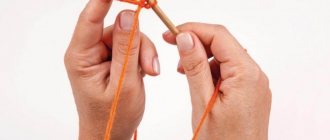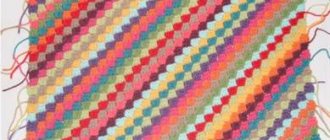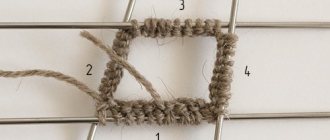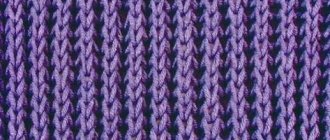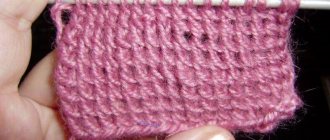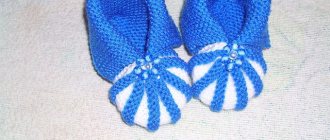Needlework
05/31/2018 Anastasia Prozheva
With the onset of cold weather, we actively begin to insulate ourselves. Various methods and options are used, we often take out warm clothes and are more than happy with knitted socks. The desire to knit something warm for yourself and your family immediately awakens. There are a large number of different knitting patterns and options. The German knitting method is the most common; our grandmothers also knitted according to such patterns. But very often difficulties arise in the process of making socks, namely at the heel stage. Therefore, today we will tell you how to knit a boomerang heel in various ways.
This master class will help you understand knitting techniques and patterns.
German way
The heel is usually knitted with several knitting needles. We divide the heel into three parts; you can use a marker to mark it if it is difficult to do this mentally. We divide all loops into middle and side parts.
To make it more convenient, we transfer all the loops on the heel to a separate knitting needle. We knit the first row with the right side, unfold the knitting and make a double loop
To make it double, we put the thread on the back side and tighten it tightly.
Then we knit the heel loops with the wrong side to the end of the row.
We unfold the knitting and make a double loop from the first loop. It turns out to be a front loop, the thread is located on the back.
We start the working thread in advance.
And we tighten it just as tightly.
And it turns out to be a double loop.
We knit all the loops up to the double loop, do not knit it and unroll the knitting. From the wrong side you need to remove the first loop and make it double. And we knit in the same way until double, 2 double loops should form.
Next we knit 1 less loop, after repeating, remove 1 loop and form a double one. We continue knitting until all the loops are double and the central ones are regular. A more detailed diagram is in the next photo.
Related article: Takori hat: knitting pattern with English rib with photos and videos
For convenience, you can place the loops on different knitting needles.
The first part of the heel is ready, then you need to knit 2 circular rows on all the loops of the sock, including the top ones.
Or just knit 2 rows back and forth, only on the heel. Only on the purl row we knit double loops from the purl side. through the back loops to create a slope.
We continue knitting the heels.
1st row - front side, knit to the end of the row of the central part. 2nd row - wrong side, remove the first loop and transform it into a double loop, knit with the wrong side to the end.
Row 3 - knit, from the first stitch we make a double stitch, knit. loops to double, we knit it together with the front one with a slope, turn the knitting. Row 4 - purl, similar knitting.
The second part of knitting is the pattern.
Brief description of crochet.
Top part.
Toe formation.
Boomerang heel knitting
Socks can be knitted with different heel designs. This can be a classic option that turns into an instep wedge and ensures comfortable wearing. There are also boomerang heel fans. And today we will tell and show how to knit a boomerang heel with knitting needles. The size chart is below.
The boomerang heel is knitted in short rows in which “double” loops are formed. The principle of knitting itself is simple, but for beginners it will require some attentiveness and composure.
The disadvantage of the boomerang heel is that it immediately forms a foot that does not have an instep wedge. It follows from this that this model is suitable only for those who have a low arch. For example, boomerang heels are ideal for knitting children's socks.
Boomerang heel with knitting needles - video:
Boomerang heel with knitting needles - diagram and description:
The number of loops (see size table below) is distributed over four knitting needles. The cuff and leg are knitted in the same way as in the classic version.
Loops from 1 and 4 knitting needles are connected, knitted and turned over to the wrong side. The second and third spokes are not involved in the work yet.
For heel knitting, the number of loops is divided into three parts. In the case when the number of loops is not divided by an equal value: “extra” loops are added to the left and right parts or to the central one. For example: 20 loops = 7 loops (left part), 6 loops (center part), 7 loops (right part).
When knitting, the left and right parts are formed into double loops, the central part remains with regular loops.
First half of heel:
- ROW 1 (wrong side): The first stitch is removed (from right to left) and a “double loop” is made from it. To do this, the thread remains BEFORE the work and then is pulled back. The result is a “double loop” on the right needle. The row is knitted to the end with purl loops.
- ROW 2 (right side): The first stitch is slipped (from right to left) and a “double loop” is made from it. To do this, the thread remains BEHIND the work and is then pulled forward. The result is a “double loop” on the right needle. The row is knitted to the end with facial loops to the “double loop”. Without knitting this loop, the work is turned over.
The first and second rows are repeated until all the loops from the side parts are converted into “double”. The hinges on the central part remain normal. Next, two rows are knitted in a circle. All double loops in the first row are knitted in the following order:
- Double loops on the left side are knitted behind the FRONT walls.
- Double loops on the right side are knitted behind the BACK walls.
Second half of heel:
- 1 ROW (front side): All loops of the central part are knitted +1 (from the left side). The work is turned upside down.
- ROW 2 (wrong side): The first loop is removed and a double loop is formed from it. The number of loops in the central part + 1 (on the right side) is knitted. The work is turned upside down.
- ROW 3 (right side): The first stitch is slipped and a double stitch is formed from it. All knit stitches are knitted + a double loop is knitted + 1 loop following it. The work is turned upside down.
- ROW 4 (wrong side): The first stitch is removed and a double loop is formed from it. All purl loops are knitted + a double loop is knitted (wrong side behind the back wall) + 1 loop following it. The work is turned upside down.
The third and fourth rows are repeated until all stitches from the left and right parts are joined to the center part through the formation of double loops.
When on the 1st and 4th needles there is one double loop on the sides on the front side, the sock begins to be knitted in a circle. Double loops are knitted as one. Next, the foot and toe are knitted, as in the classic model.
Size table:
Size chart based on knitting density: 10 x 10 cm fabric includes 28 loops and 40 rows.
Size 32-35
number of loops on the knitting needle - 44/11; number of heel loops - 22; distribution of loops for the boomerang heel - 7 / 8 / 7; length of the foot from the center of the heel to the toe – 11.
Size 36-38
number of loops on the knitting needle - 48/12; number of heel loops - 24; distribution of loops for the boomerang heel - 8 / 8 / 8; length of the foot from the center of the heel to the toe – 13.
Size 39-41
number of loops on the knitting needle - 52/13; number of loops for the heel wall - 26; distribution of loops for the boomerang heel - 9 / 8 / 9; foot length from the center of the heel to the toe is 14-15.
Size 42-44
number of loops on the knitting needle - 56/14; number of loops for the heel wall - 28; distribution of loops for the boomerang heel - 9 / 10 / 9; length of the foot from the center of the heel to the toe – 16.
How to knit a boomerang heel: traditional method and others
The first method is traditional and most common. Below is a step-by-step master class with photos of the process.
Step one. You should start knitting the boomerang heel after the cuff and sock shaft are ready. The basis of such a heel is the so-called partial knitting. You should start knitting a “boomerang” with shortened rows. In the first row you need to knit thirty-one stitches.
Step two. Turn the knitting over, yarn over, then purl the next row.
The row must not be knitted completely, but one loop must be left on the knitting needle.
Step three. The knitting should be turned over again, yarn over and knit a row with facial loops. Leave one last loop as well.
Thus, the knitting of the heel gradually narrows, taking on the shape of a trapezoid. On vertical knitting needles, the slipped loops should replace the yarn overs.
Knit until there are ten stitches left on the working knitting needle.
Step four. Knit one round row. The removed loops and yarn overs must be knitted together. To achieve a uniform knitting density, it is recommended to place the loop over the yarn over before knitting. The loops in the circular row must be knit stitches. After this, you need to knit another circular row. Yarn overs should be placed under the knit stitches and knitted together. Half of the boomerang is ready.
Step five. The second half of the heel, of course, should be symmetrical. The central ten loops are knitted with facial loops.
Step six. Turn the knitting over, make a yarn over, knit a row with knit stitches.
Step seven. Repeat steps five and six. The casts and stitches at the end of the rows must be knitted together. It is important to pay attention to the fact that the yarn over at the end of the purl row, when knitting it, is on the wrong side of the heel. Continue knitting until there are thirty-two stitches on the needles. After this, you need to knit the boomerang heel in circular rows.
A heel called “boomerang” is made.
A heel made using this technique looks very elegant. German way.
Below is a description of another boomerang heel knitting technique called “German”. It differs from the previous method by using double loops. Knitting is done with facial loops. Before starting work, you need to mentally divide the number of loops on which the boomerang heel is knitted into three parts (two side and one central part). Below are two diagrams that will be needed in the process.
Now we can begin.
- To begin with, you should transfer all the knitting loops to one knitting needle. Knit one row with knit stitches.
- Turn the knitting over and slip off the first stitch. In order to make a double one out of it, you need to place the thread that is used to do the work on the back side of the canvas and tighten it as tightly as possible. As a result, the loop on the knitting needle should pull the walls of the loop underneath it.
- Purl one row. Turn the work over again, remove the first loop and make a double loop out of it in the manner described in the previous paragraph.
- Knit one row. There is no need to knit the last double loop. Turn the knitting over, make a double loop and knit one row with purl loops. Now the last two double loops do not need to be knitted.
- In each subsequent row, therefore, it will be necessary to knit one less loop. Repeat the steps until all the loops of the two side parts that were determined before starting work become double. The hinges of the central part should remain in place.
- Next, you should make two circular rows in all loops (including at the top of the foot). The slope of the double loops knitted together should be directed towards the center.
- Knit the first row of the second part of the “boomerang” with facial loops. Turn the fabric over, make a double stitch and purl the second row.
- Knit the third row again with knit stitches to double stitches, and knit it with a slant to the right along with the knit stitch. Make one knit stitch and turn the sock over as usual.
- In the fourth row, knit the first double loop together with the purl loop behind the back walls and perform one purl loop.
- Alternate rows three and four. When all the boomerang heel loops are knitted, the outermost loops on each side should be double. They will need to be knitted in the next round.
- Continue knitting in circular rows.
Knitting a German boomerang heel is completed!
